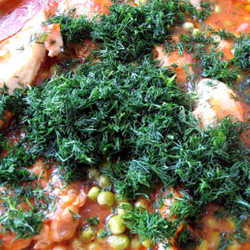The fact that I frequently mention boys in my articles has nothing to do with whether or not I was boy crazy, as Aunt Bett would have said. The simple fact was, there were no girls my age living nearby. And the boys were not really the objects of my affection as much as they were the objects of my competitive nature. Anything they could do I had to do better. I did a lot of boy chasing, though. They stole my hair ribbons and ran, so I chased them, caught them, and knocked them flat, usually. Most of them did not tell on me because what boy would ever admit that he was chased and caught by one little girl? I learned early on that if I chewed on a twig, a leaf, or the stem of a plant when I was around one of the boys, he would undoubtedly reach over and grab a bit of the same plant and start chewing on it, too. What is it about men that makes them do that? Anyway, that's how I got them to chew lovage leaves.
My Aunt Bett made a tonic from the plant, so I knew it was safe to chew. As a matter of fact, she kept a bunch of its dried leaves handy, because she thought it helped with digestion. If I ever had a tummy ache, a mild tea made of lovage is what she gave me. Another thing about lovage that appealed to the boys is the fact that it has a hollow stem. I learned to use it much like a pea shooter, and that always impressed them. They wanted their own pea shooter. I had not a clue what it meant to have a boyfriend, or even how a love potion might work. I was more interested in seeing if it affected them in strange and unusual ways, because they always seemed somewhat a mystery to me anyway.
With their strong aromatic flavor, the leaves and stems of lovage have been a soup and stew ingredient, and the stalks have been blanched as a vegetable ever since classical antiquity. Levisticum officinale grows in gardens, meadows and hedge rose. It was introduced from Europe, and is generally cultivated, though it may escape cultivation frequently. It grows from New Jersey to Virginia and west to Missouri and New Mexico. It is a perennial herb, three to seven feet tall, and has dense clusters of tiny pale yellow flowers from May through July. The flowers are arranged in umbels atop a thick hollow stem. The leaves are divided several times, with lobed or sharply toothed leaflets. The lower leaves may grow 2 feet long. The plant has a strong celery-like smell. 
Like its relative celery, the plant is said to relieve pains related to gas. This power has been attributed to it by writers from the ancient Greeks to present day pharmacologists. Some folks in the northeast planted lovage for its roots, too, which they candied and used as a sweet and a breath lozenge. And the fruits of the lovage can be used as a spice. Nineteenth century Shaker communities grew and sold lovage as part of their commercial enterprises. Herbalists have also recommended various preparations of the root for a healthy urinary tract. It has also been used as an external wash or lotion since it is thought by some to be antiseptic.
The plant does smell and taste much like celery. Even today what is sold as celery seed sometimes is partially or entirely ground lovage seed. The name lovage goes back to a Latin word meaning "Ligurian," because the herb flourished in ancient times in Liguria, a region that includes the Italian Riviera. The name was garbled beyond recognition by the time it reached English, and in Chaucer's day it was known as love-ache, or love parsley. Lots of people, including me, were misled by the name, and fancied a connection between lovage and love potions.
Present day pharmacologists have agreed that lovage has proven value for relieving gas pains and research indicates that it probably is beneficial as a breath deodorizer. But they have not confirmed it as a love potion. That breaks my heart. It might not have worked on my 10-year-old boyfriends, but I have been thinking of whipping up a batch just to have handy in case I needed it. If nothing else, he could be assured of good smelling breath.
The following is information shared by a reader, LeBug, from Greenville, Indiana:
Lovage is your ally in the battle against garden pests. The flower heads (umbels) are made up of hundreds of tiny flowerlets that provide nectar to feed the adults of tiny mosquito-sized parasitic wasps which will then lay their eggs in your soft-bodied garden pests. When the egg hatches, it destroys the pest by eating it from the inside. The tiny flowerlets allow the quarter inch long wasps to feed on nectar where larger flowers make feeding difficult for the tiny wasps. So if you can get the adults to stick around by providing them with a food source, you will notice less pest damage in your garden. This is from Snakeroot Organic Farm.
For the butterfly lovers too. Lovage is a host plant for Black Swallowtail; Anise Swallowtails. I discovered cats on mine at the end of the summer one year and have found them on it every year since. ~~~Thank you, LeBug!
Research for this article came from Wikipedia: http://en.wikipedia.org/wiki/Lovage
Photos are from Plant Files. Thanks to the following photographers for the use of their images:Ladyann , Mgarr, and Poppysue.

















